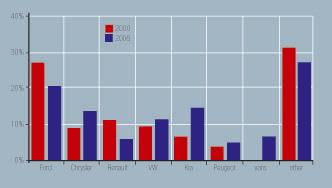However, there are now interesting signs of life for big MPVs. Over the last couple of months, the biggest selling MPV has been the Ford S-Max – the MPV for people who don’t like MPVs.
Ford does seem to be persuading buyers that the S-Max is not nearly as ‘beige cardigan’ as traditional models, and that owners can cut a bit of a dash with an S-Max.
It must also be the first Ford in history that arguably has a higher image than its Mercedes equivalent: an S-Max on the drive may well be preferable to a Mercedes-Benz Viano.
However, before product planners all scribble memos saying how funky their next MPV must be, the S-Max’s polar opposite is also having unexpected success.
When launched last year, it seemed destined only to provide an opportunity for motoring journalists to get a cheap laugh. Variously described as “Britain’s ugliest car” and a “comedy MPV”, step forward the SsangYong Rodius.
So far this year, it has taken a rather modest 1.2% segment share, but it is in the unlikely situation of being unable to meet demand. SsangYong dealers are actually asking for bigger allocations, but the importer understandably set very modest targets and has no more to sell.
So what on earth is going on, when dealers are fighting to sell a car so weird that even its own manufacturer can’t defend its looks?
In fact the S-Max and Rodius do share one thing in common, from a marketing point of view. Put simply, they answer the question: “What is this car for?”
The S-Max is the funky MPV and the Rodius USP is simple – “You can carry seven people and their luggage and get change from £15K”. As ever, it is the middling vehicles that are in trouble.
Nobody aspires to an MPV – although the S-Max 20v Turbo is trying single-handedly to change that state of affairs. People generally buy them out of necessity, like a new fridge.
In such a market, it is no surprise that the Kia Sedona has periodically been Britain’s best selling retail MPV. A more prestigious badge or a free DVD system to keep the kids quiet? It’s not a hard choice for a harassed parent.
This requirement for value is being taken to its logical conclusion with the rise of ‘vans with windows’.
More than 6% of all MPVs sold so far this year have been vehicles usually classified as vans, such as the Peugeot Expert, Renault Trafic and VW Transporter.
Of course, many of these are being sold for taxi duty, but it is interesting that the dividing line between vans and MPVs is blurring.
Even private buyers are starting to look at vans. After all, if you want the best possible space to cost ratio, a Trafic can look quite attractive next to an Espace…
MPV share by carmaker

Ford’s share has dropped because of the changeover to the new Galaxy/S-Max this year, but will soon rise again.
It is interesting that the ever-more luxurious Renault Espace has suffered in recent years. The MPV is seen as an alternative to an executive car in France, but British buyers seem unconvinced as yet.












Login to comment
Comments
No comments have been made yet.